Brewing Kombucha Part 1: How to Grow a Scoby
If you’re here then I’m guessing you already know what kombucha is, and about the benefits of drinking it so I’m just going to share with you my techniques and tips for brewing kombucha from start to finish.
I’ve been brewing my own kombucha for a few years now. I began because it was just getting too expensive to buy, which is the reason I think most people start brewing their own. My husband brews beer so I’m constantly surrounded by men transferring, hopping and kegging so I figured I could probably figure out how to brew my own kombucha, and I would have plenty of people around to help me if I needed it (which I didn’t, and neither will you). Besides saving a bit of money I like to brew my own for a few reasons:
- It’s a fun (dorky) science experiment that you get to drink.
- You get to control the flavor and experiment with different teas, fruits, herbs etc…
- You can control the amount of sugar (some bottles of store-bought brew have 18 grams of sugar which is insane).
The first step in starting the brewing process is to grow your own scoby. The SCOBY (acronym for symbiotic culture of bacteria and yeast) basically is what turns sweet tea into fizzy fermented kombucha. It floats at the top of the brew vessel and looks like a flesh or white colored rubber/jello disc. which keeps any bacteria out, and traps the CO2 that is being produced which gives it carbonation. A scoby can also be referred to as a “mother” or “mushroom.” It will grow a new layer with each batch you brew and it will become thicker and thicker.
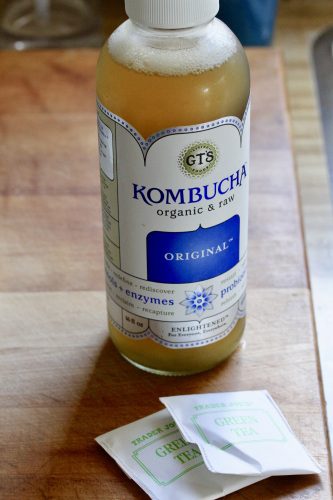
If you know someone who has a scoby they can literally just cut a piece off of theirs and you can use that instead of the store-bought one I’ll be using in this process. You can grow your own which is super easy too (it is how I started mine). Have you ever been drinking kombucha and come across a mucus-y blob? Sorry there’s no better way to describe it. It can either be at the very top of the bottle or in the bottom of the bottle. This is a baby scoby which you will grow into a larger one by feeding it a sweet tea over 2-3 weeks. The process described below is basically this: brew a super sweet tea and let it cool, add the scoby along with some of the kombucha, cover it and set it in your closet to grow for a few weeks. You should know that this first batch of scoby-growing kombucha will not be drinkable so you’ll have to wait for the next batch.
Have fun!
Here’s a visual progression of the growing scoby:
At 5 days old
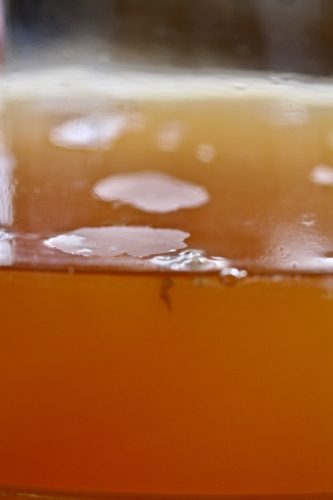
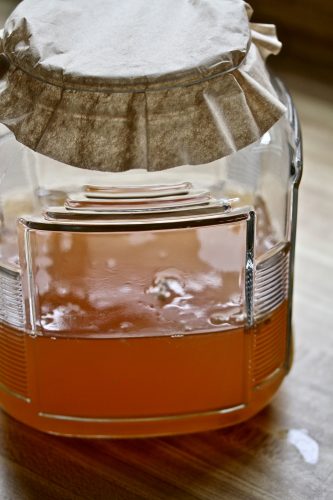
At one week old
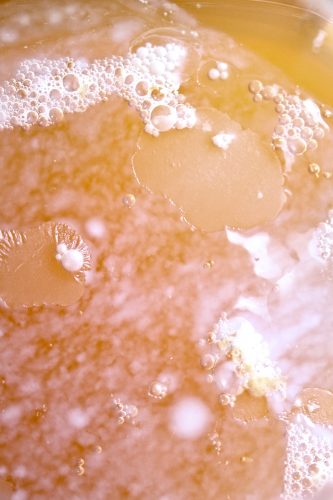
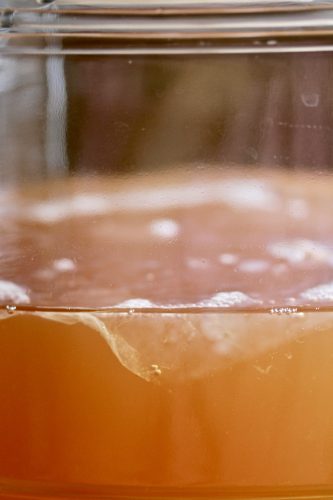
At 9 days old
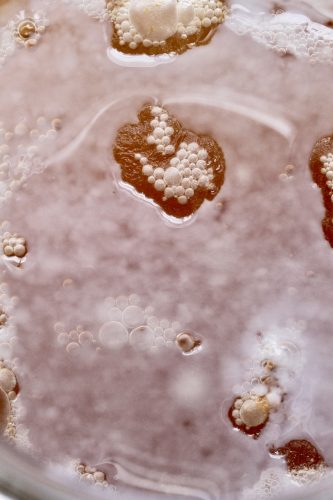
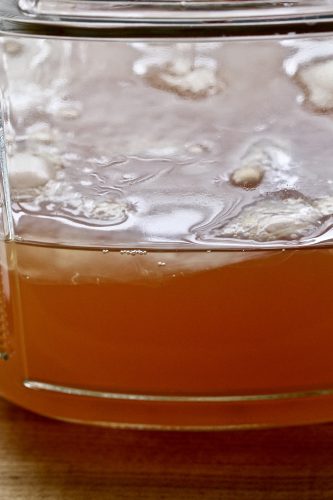
At 2 weeks old
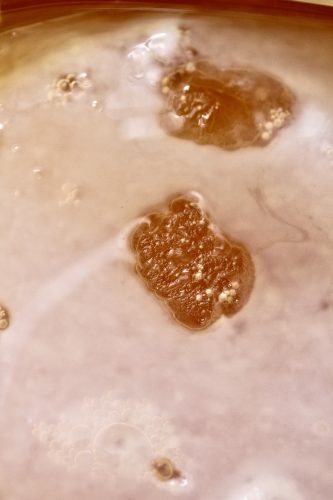
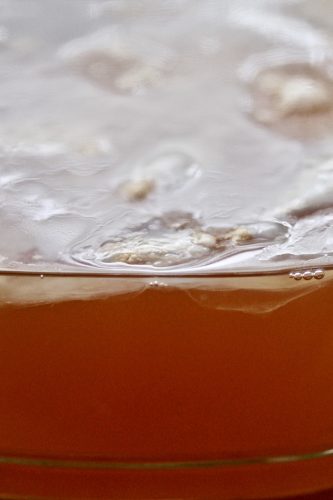
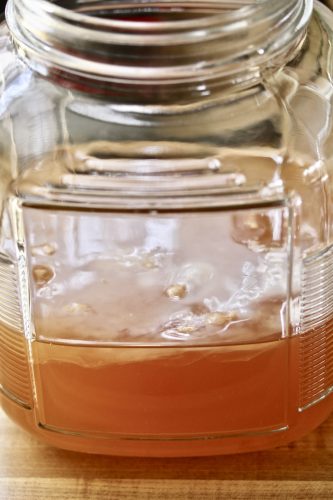
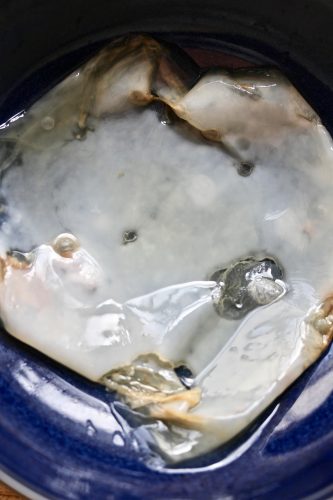
- 1 bottle of original flavor kombucha (no fruit or other flavors)
- 6 cups water
- 1 cup white sugar
- 4 green tea bags (I use Trader Joes green tea)
- large glass canning car (I use a gallon jar because that's what I use to brew my bigger batches but you can use a smaller one that fits 6 cups of liquid)
- coffee filter
- rubber band
- Bring water to a boil in a small (clean) pot.
- Remove tea bags from paper and remove the paper from the end of the strings.
- Add tea bags to boiling water and remove from heat. Add sugar and stir in until dissolved with a clean spoon. Cover with a clean lid and let cool completely.
- When tea is totally cool pour it into the glass jar. Add scoby from storebought original kombucha along with 2 cups of the kombucha it came in (see notes above).
- Cover with coffee filter and secure with rubber band. Set in a dark cool place for 2-3 weeks, moving it gently if you need to check on it, until a white thick scoby forms on the top (see pictures).
- Use green tea and regular white sugar. I've tried black tea and it doesn't work really well in creating kombucha with a nice carbonation, although some people will say you can use it. I've definitely had the best luck with green tea and I like the lighter flavor better anyway.
- Let your bottle of kombucha sit out for a few minutes (but not loo long) just so that the scoby and the cloudy bits will settle to the bottom of the bottle (this is the part you want to add to your scoby-growing jar), and just pour off the clear stuff at the top to drink.
- If you plan on brewing your kombucha in a wider jar, use a wider jar to grow your scoby. A growing scoby will cover the whole surface of whatever vessel you put it in and the next batch will ferment faster with a larger scoby that covers more of the surface. I use these jars to brew, which you can also buy at Target and have a fairly wide mouth and hold one gallon.
- Make sure your brewed sweet tea is totally cool because if it is hot at all it will kill the baby scoby. I will usually brew my tea at night and let it sit out all night so that it is cool by morning. For this process you won't have to brew that much tea though, so it should be cool fairly quickly.
- Make sure all your equipment is very clean (hands too) and you rinse any soap reside out of jars, utensils, pots, etc... I have had a batch of kobucha suddenly grow mold on me, and I will never know why but I had to restart this whole process. If you start to get anything that looks fuzzy on the surface (bubbles are normal even if they're a darker color) then it is usually a mold problem. You won't be able to remove it and save the batch, you'll just have to start over.
- Keep the scoby starter out of sunlight or anywhere too cold or too warm. I have a pantry/closet that I keep all my kombucha starters and brew vessels in, in which they seem to be happy. Don't move your starter around too much if you can help it.
- My scoby will take about 2 weeks to grow healthy enough (thick and wide) but will still have some small holes in it, which I've found to be just fine for brewing the next batch and it will continue to grow. The first batch you brew with your new scoby might take a little longer than the next batches because as your scoby grows it will ferment at a faster rate. Sometimes I will have to remove a layer from an older scoby so that it doesn't ferment too rapidly and cause too much of a vinegary taste. More on that in part 2.

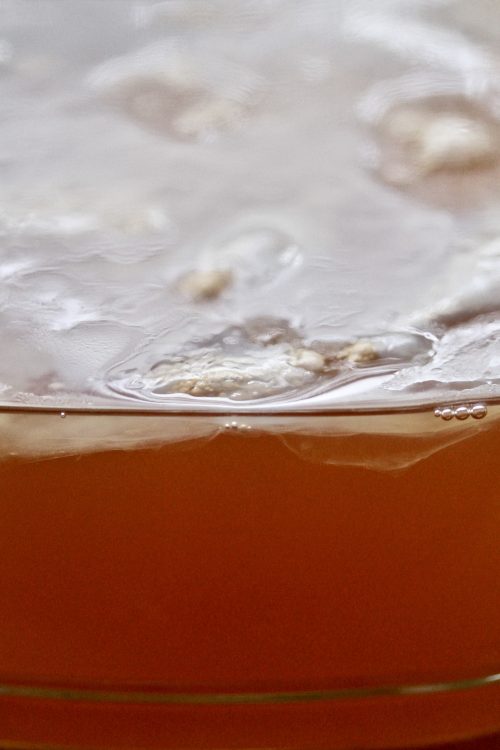
Brewing Kombucha Part 2: Fermentation – The Sea Salt
July 6, 2018 @ 4:45 pm
[…] After growing your scoby the next step in brewing your own kombucha is your first fermentation. In this prcocess you’ll brew a pot of tea (similar to when you grew your scoby, but with less sugar and more volume), let it cool and then add your scoby. It usually takes about 5-7 days for this first batch since your scoby is still growing and not super efficient yet. Your next batch will take fewer days. I don’t like to let the kombucha ferment too long because I like a less vinegary, and a lighter tasting kombucha. After this fermentation is when you’ll be able to add the flavors that you want, and then drink it shortly after that. […]
Brewing Kombucha Part 3: Second Fermentation and Adding Flavor – The Sea Salt
July 12, 2018 @ 4:03 pm
[…] now, you’ve made your own scoby, and done your first fermation. So at this point you should have a jar of booch that has a healthy […]